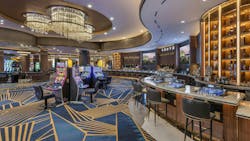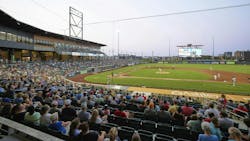Secondary Markets on the Rise as Entertainment Hubs
Tourism seems to be booming once again.
Not only did the U.S. hotel industry post record highs in average daily rate and revenue per available room last year, but it is forecasted to perform better than the overall U.S. economy in 2024, according to the commercial real estate analytics company CoStar.
Mixed-use complexes, anchored by sports and entertainment, are developing in major league and secondary markets, and cities are revitalizing their centers with outdoor leisure options, entertainment, hospitality and retail.
“Consumers are seeking new and unique experiences that offer a variety of ways to gather and create memories. Intentional design provides visitors with a unique sense of place and offers something new and exciting to explore,” said Brian Murch, principal and hospitality design leader, DLR Group, Kansas City.
But while entertainment-themed projects can do wonders for tourism and local economies, financing these initiatives can be challenging.
“Overcoming these financial challenges demands strategic planning, meticulous budgeting and a thorough understanding of market dynamics to ensure the project's financial viability and success,” he said.
Adding complexity in urban areas are high land costs, space limitations, sustainability considerations and sometimes historic preservation. And with sports venues, owners are challenged to drive revenue with events on non-game days.
“A collaborative team can work closely with ownership to establish clear project goals, budgetary constraints and timelines,” Murch offered on guidance for executing such projects. “This allows for effective cost tracking and management throughout the design phase. By leveraging their collective knowledge and experience, the team can identify potential cost-saving opportunities, mitigate risks and resolve challenges proactively, minimizing delays and costly revisions.”
Below, find a snapshot of a few projects getting it right, in developing cities attracting tourists and locals alike.
Rolling into Raleigh
Home to 189 restaurants, 30+ craft breweries, 10 universities and many sports and entertainment options, Raleigh, NC is ranked as one of the best places to live in America.
According to a 2023 Wake County tourism report, hotel lodging and prepared food and beverage tax collections increased by almost $10 million from 2022 to 2023, with a 15.6% increase in hotel occupancy and a 9.3% jump in prepared food and beverage tax collections.
“A thriving city of the new South, Raleigh is North Carolina’s state capital and also seat of its most populous county—historically drawing professional sports teams to locate here as well as industries or conventions related to state government/university business,” stated Jonathan Freeze, vice president of marketing and communications, Greater Raleigh Convention and Visitors Bureau (GRCVB). “The entertainment, sports and nightlife scenes are fueled by matriculating students, many of whom later become residents. The climate is temperate year-round and tourism is year-round rather than seasonal.”
The largest development projects in the area include:
Red Hat Amphitheater: The 6,000-person, 14-year-old amphitheater is undergoing relocation to make room for the Raleigh Convention Center expansion. According to the GRCVB, 69% of attendees are tourists. This indicates that “this venue remains a core outdoor music venue for attracting visits to Raleigh,” explained Freeze.
PNC Arena: Home of the NHL’s Carolina Hurricanes and North Carolina State University men’s basketball, the 25-year-old 19,700-seat venue is elevating the fan experience with new seating configurations, food offerings and improved building infrastructure. Outside of games, the arena hosted 56 concerts and shows last year.
Dorothea Dix Park: Formerly allocated for state government/hospital land use, 308 acres are being developed into a new destination park. As the city’s largest green space, the scale of the municipal park planning is unparalleled in the U.S. The first phase, Gipson Play Plaza, comprises new landscaping, fountains, gardens, a waterfall, picnic grounds, civic plaza and a playground that includes climbing towers, a sand bowl, swings and more.
Cary Indoor Sports Facility/Center at South Hills: The complex will provide about 100,000 square feet of indoor competition space for sports such as basketball, volleyball and esports.
When in Wichita
Looking to spur growth in Wichita, KS, the city recently negotiated a deal to relocate the Double-A Minnesota Twins farm team Wichita Wind Surge from New Orleans.
“With its rich baseball history, quality of life and the need for new entertainment outlets for its community, the move made sense,” said Don Barnum, principal and global sports leader, DLR Group, Kansas City. “To make it even more beneficial for all parties, low priced leasing of ground adjacent to the stadium allowed team ownership to capture additional financial advantage.”
Riverfront Stadium has been sited to accommodate the future Wichita Sports Museum and a mixed-use development with hotels, restaurants and entertainment venues on the Arkansas River. With a capacity of 10,000 seats, this includes traditional stadium seats, berm seats, loge boxes, outfield standing-room only, drink rail seats, a picnic area, a river front party deck, an upper-level party deck, club seats and suites.
“The facility's architecture captures the character of the adjacent Delano District in materials and color palette,” added Barnum.
Dealing In
With the recent expansion of its Woodlands Casino, Foxwoods in the rural town of Mashantucket, Conn., now bears the distinction of the world’s largest casino resort.
Owned and operated by the Mashantucket Pequot Tribe, ZDS Architecture worked closely with the native American community to honor the Pequot heritage through abstract representations of the Mashantucket woodlands and Pequot symbols.
Unlike urban casinos, the surrounding natural environment presents a beautiful backdrop of wooded, rolling hills.
“The design resembles a forest-like atmosphere, honoring the land that the casino is located on, with Pequot symbols interwoven in the geometry of the carpet design, details of the decorative lighting and graphics throughout the space,” said Bob Macaruso, associate, director of interior design, ZDS Architecture, Providence, R.I.
Another goal was making the resort a family-friendly entertainment destination. Toward this end, there’s a Top Golf Swing Suite Barcade with vintage arcade games, a custom bar with integrated gaming, VIP lounge areas, an open display specialty pizza kitchen and a Gordon Ramsay Hell’s Kitchen restaurant.
Meanwhile in Dubuque, Iowa, the Q Casino Resort features a casino, sportsbook, sports bar, inclusive family entertainment zone, boutique hotel with rooftop restaurant and bar, and event and meeting spaces.
Located on the historic Schmitt Island, DLR Group’s design integrates fluid and rippling elements of the Mississippi River and pays tribute to the location’s racing history. Also lending a sense of place, the adjacent boutique hotel incorporates the rich limestone from the surrounding bluffs and the lush wood of the area’s oak trees.
About the Author
Barbara Horwitz-Bennett
Contributing Editor
Barbara Horwitz-Bennett has been covering the AEC industry for the past 25 years. She writes for a number of industry magazines and works with AEC firms and product manufacturers on content writing projects.




